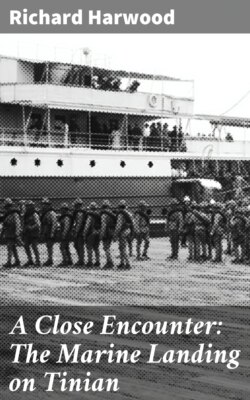Читать книгу A Close Encounter: The Marine Landing on Tinian - Richard Harwood - Страница 6
На сайте Литреса книга снята с продажи.
Оглавление[Sidebar (page 3)]:
Selection of White Beach
Table of Contents
The selection of the northwestern beaches was universally regarded as the key to the quick success of the Tinian operation. The credit for this choice, however, has been debated for years. Carl Hoffman, in his history of the battle, quoted Major General Harry Schmidt on the issue: “Many high ranking officers have asked who originated the plan. … While the 4th Division was under my command and prior to the Marianas campaign, my planning officer, Lieutenant Colonel Evans F. Carlson, made such a plan and probably such a plan was turned in to the V Amphibious Corps.”
The division’s intelligence officer, Lieutenant Colonel Gooderham L. McCormick, a Reservist who later became mayor of Phildelphia, agreed. So did Lieutenant Victor Maghakian of the division’s reconnaissance unit: “The man who definitely planned that landing … was Evans F. Carlson. … He told me all about that Tinian plan before he was wounded [22 June] on Saipan.”
Others minimized Carlson’s role, including Marine Major General Graves B. Erskine, who was then the V Amphibious Corps chief of staff, and Marine Colonel Robert E. Hogaboom, the operations officer for the landing forces at Saipan and Tinian. Admiral Harry W. Hill, commander of the Northern Attack Force, told Hoffman that “if there were plans and I presume there were tentative ones, none of them were available to me or my staff.”
Hoffman discovered that before the war, students at the Marine Corps Schools at Quantico had come up with the northern beaches solution to the “then-theoretical Tinian solution.”
But historian Ronald Spector, in his Pacific war history, Eagle Against the Sun, left no doubt who had forced the issue. It was Marine Lieutenant General Holland M. Smith. When he and Admiral Hill proposed the use of White Beaches 1 and 2, Admiral Turner firmly vetoed [the] proposal and told [Hill] to work on planning for a landing near Tinian Town. Hill reluctantly complied, but he ordered part of his staff to keep working on the White Beaches plan. … [After reconnaissance reports] Hill and Smith tried once again to change Admiral Turner’s mind, but he remained obstinate.
In a characteristic exchange, the admiral told General Smith: “You are not going to land on the White Beaches; I won’t land you there.” “Oh yes you will,” replied the general. “You’ll land me any goddamned place I tell you to.” Turner was adamant: “I’m telling you now it can’t be done. It’s absolutely impossible.” “How do you know it’s impossible?” asked Smith. “You’re just so goddamned scared that some of your boats will be hurt.”
Neither this exchange nor the more subtle efforts of Admiral Hill served to convince Turner, so Hill reluctantly took the matter to Admiral Spruance [Turner’s superior]. Spruance liked the White Beaches idea, but he was reluctant to overrule Turner, his expert on amphibious warfare. A conference with Turner and his subordinate commanders was arranged on board the flagship. All spoke in favor of the White Beaches. Spruance turned to Turner. The latter calmly announced that he favored the White Beaches also.
In a letter written to Hoffman in 1950, Turner said: “… before the reconnaissances of July 10 and 11 were made, I had (without announcement) tentatively decided to accept the White Beaches unless the reconnaissance reports were decidedly unfavorable.”
This was one of those cases, as John F. Kennedy once said, in which “victory has many fathers but defeat is an orphan.”
